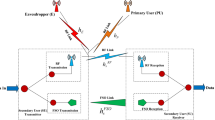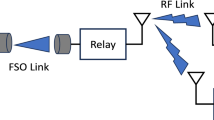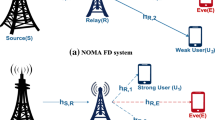Abstract
With the completion of the standardization of fifth-generation (5G) networks, the researchers have begun visioning sixth-generation (6G) networks that are predicted to be human-centric. Hence, similar to 5G networks, besides high data rates, providing secrecy and privacy will be the center of attention by the wireless research community. To support the visions beyond 5G and 6G, in this paper we propose a secure radio frequency (RF)-free space optical (FSO) mixed framework under the attempt of wiretapping by an eavesdropper at the RF hop. We assume the RF links undergo \(\alpha -\eta -\mu\) fading whereas the FSO link exhibits a unified Málaga turbulence model with pointing error. The secrecy performance is evaluated by deducing expressions for three secrecy metrics i.e. average secrecy capacity, secrecy outage probability, and probability of non-zero secrecy capacity in terms of univariate and bivariate Meijer’s G and Fox’s H functions. We further capitalize on these expressions to demonstrate the impacts of fading, atmospheric turbulence, and pointing errors and show a comparison between two detection techniques (i.e. heterodyne detection (HD) and intensity modulation with direct detection (IM/DD)) that clearly reveals better secrecy can be achieved with HD technique relative to the IM/DD method. The inclusion of generalized fading models at the RF and FSO hops offers the unification of several classical scenarios as special cases thereby exhibiting a more generic nature relative to the existing literature. Finally, all the analytical results are corroborated via Monte-Carlo simulations.














Similar content being viewed by others
Data availability
The data sets generated during and/or analyzed during the current study are not publicly available but are available from the corresponding author upon reasonable request.
Code availability
Codes are available from the corresponding author upon reasonable request.
References
Abd El-Malek, A.H., Salhab, A.M., Zummo, S.A., Alouini, M.-S.: Security-reliability trade-off analysis for multiuser SIMO mixed RF/FSO relay networks with opportunistic user scheduling. IEEE Trans. Wirel. Commun. 15(9), 5904–5918 (2016)
Abd El-Malek, A.H., Salhab, A.M., Zummo, S.A., Alouini, M.-S.: Effect of RF interference on the security-reliability tradeoff analysis of multiuser mixed RF/FSO relay networks with power allocation. J. Lightwave Technol. 35(9), 1490–1505 (2017)
Abramowitz, M., Stegun, I.A., et al.: Handbook of mathematical functions: with formulas, graphs, and mathematical tables, vol. 55. National bureau of standards Washington, DC (1972)
Alimi, I.A., Monteiro, P.P., Teixeira, A.L.: Analysis of multiuser mixed RF/FSO relay networks for performance improvements in cloud computing-based radio access networks (CC-RANs). Opt. Commun. 402, 653–661 (2017)
Al-Qahtani, F.S., El-Malek, A.H.A., Ansari, I.S., Radaydeh, R.M., Zummo, S.A.: Outage analysis of mixed underlay cognitive RF MIMO and FSO relaying with interference reduction. IEEE Photonics J. 9(2), 1–22 (2017). https://doi.org/10.1109/JPHOT.2017.2665969
Amirabadi, M.A., Vakili, V.T.: Performance of a relay-assisted hybrid FSO/RF communication system. Phys. Commun. 35, 100729 (2019)
Amirabadi, M.A., Vakili, V.T.: On the performance of a multi-user multi-hop hybrid FSO/RF communication system. Opt. Commun. 444, 172–183 (2019)
Anees, S., Bhatnagar, M.R.: Performance evaluation of decode-and-forward dual-hop asymmetric radio frequency-free space optical communication system. IET Optoelectron. 9(5), 232–240 (2015)
Anees, S., Bhatnagar, M.R.: Performance of an amplify-and-forward dual-hop asymmetric RF-FSO communication system. J. Opt. Commun. Netw. 7(2), 124–135 (2015)
Ansari, I.S., Abdallah, M.M., Alouini, M., Qaraqe, K.A.: A performance study of two hop transmission in mixed underlay RF and FSO fading channels. In: 2014 IEEE Wireless Communications and Networking Conference (WCNC), pp. 388–393 (2014). https://doi.org/10.1109/WCNC.2014.6952039
Ansari, I.S., Abdallah, M.M., Alouini, M., Qaraqe, K.A.: Outage analysis of asymmetric RF-FSO systems. In: 2016 IEEE 84th Vehicular Technology Conference (VTC-Fall), pp. 1–6 (2016). https://doi.org/10.1109/VTCFall.2016.7881143
Ansari, I.S., Abdallah, M.M., Alouini, M., Qaraqe, K.A.: Outage performance analysis of underlay cognitive RF and FSO wireless channels. In: 2014 3rd International Workshop in Optical Wireless Communications (IWOW), pp. 6–10 (2014). https://doi.org/10.1109/IWOW.2014.6950766
Ansari, I.S., Alouini, M., Cheng, J.: On the capacity of FSO links under Lognormal and Rician-Lognormal turbulences. In: 2014 IEEE 80th Vehicular Technology Conference (VTC2014-Fall), pp. 1–6 (2014). https://doi.org/10.1109/VTCFall.2014.6966082
Ansari, I.S., Alouini, M.: Asymptotic ergodic capacity analysis of composite Lognormal shadowed channels. In: 2015 IEEE 81st Vehicular Technology Conference (VTC Spring), pp. 1–5 (2015). https://doi.org/10.1109/VTCSpring.2015.7145711
Ansari, I.S., Alouini, M.: On the performance analysis of digital communications over Weibull-Gamma channels. In: 2015 IEEE 81st Vehicular Technology Conference (VTC Spring), pp. 1–7 (2015). https://doi.org/10.1109/VTCSpring.2015.7145973
Ansari, I.S., Yilmaz, F., Alouini, M.: On the sum of squared \(\eta\)-\(\mu\) random variates with application to the performance of wireless communication systems. In: 2013 IEEE 77th Vehicular Technology Conference (VTC Spring), pp. 1–6 (2013). https://doi.org/10.1109/VTCSpring.2013.6692669
Ansari, I.S.: Composite and cascaded generalized-\({K}\) fading channel modeling and their diversity and performance analysis (2010). https://doi.org/10.25781/KAUST-8F80X
Ansari, I.S., Yilmaz, F., Alouini, M.-S.: Performance analysis of free-space optical links over Málaga (\({\cal{M} }\)) turbulence channels with pointing errors. IEEE Trans. Wirel. Commun. 15(1), 91–102 (2015)
Arya, S., Chung, Y.-H.: Multiuser interference-limited petahertz wireless communications over Málaga fading channels. IEEE Access 8, 137356–137369 (2020)
Asgari-Forooshani, A., Aghabozorgi, M., Soleimani-Nasab, E., Khalighi, M.A.: Performance analysis of mixed RF/FSO cooperative systems with wireless power transfer. Phys. Commun. 33, 187–198 (2019)
Badarneh, O.S.: Error rate analysis of \({M}\)-ary phase shift keying in \(\alpha -\eta -\mu\) fading channels subject to additive Laplacian noise. IEEE Commun. Lett. 19(7), 1253–1256 (2015)
Badarneh, O.S., Aloqlah, M.S.: Performance analysis of digital communication systems over \(\alpha\)-\(\eta\)-\(\mu\) fading channels. IEEE Trans. Veh. Technol. 65(10), 7972–7981 (2015)
Badrudduza, A., Islam, S.H., Kundu, M.K., Ansari, I.S.: Secrecy performance of \(\alpha\)- \(\kappa\)- \(\mu\) shadowed fading channel. ICT Express (2021)
Badrudduza, A., Sarkar, M., Kundu, M.: Enhancing security in multicasting through correlated Nakagami-\(m\) fading channels with opportunistic relaying. Phys. Commun. 43, 101177 (2020)
Badrudduza, A., Ibrahim, M., Islam, S.R., Hossen, M.S., Kundu, M.K., Ansari, I.S., Yu, H.: Security at the physical layer over GG fading and mEGG turbulence induced RF-UOWC mixed system. IEEE Access 9, 18123–18136 (2021)
Chen, L., Wang, W.: Multi-diversity combining and selection for relay-assisted mixed RF/FSO system. Opt. Commun. 405, 1–7 (2017)
Dang, S., Amin, O., Shihada, B., Alouini, M.-S.: What should 6G be? Nat. Electron. 3(1), 20–29 (2020)
El-Malek, A.H.A., Salhab, A.M., Zummo, S.A., Alouini, M.-S.: Physical layer security enhancement in multiuser mixed RF/FSO relay networks under RF interference. In: 2017 IEEE Wireless Communications and Networking Conference (WCNC), pp. 1–6 (2017). IEEE
Erdogan, E.: On the performance of cognitive underlay RF/FSO communication systems with limited feedback. Opt. Commun. 444, 87–92 (2019)
Erdogan, E.: Joint user and relay selection for relay-aided RF/FSO systems over exponentiated Weibull fading channels. Opt. Commun. 436, 209–215 (2019)
Feng, J., Zhao, X.: Performance analysis of mixed RF/FSO systems with STBC users. Opt. Commun. 381, 244–252 (2016)
Gradshteyn, I.S., Ryzhik, I.M.: Table of Integrals, Series, and Products. Academic Press, Cambridge (2014)
Han, L., Jiang, H., You, Y., Ghassemlooy, Z.: On the performance of a mixed RF/MIMO FSO variable gain dual-hop transmission system. Opt. Commun. 420, 59–64 (2018)
Hossain, T., Shabab, S., Badrudduza, A.S.M., Kundu, M.K., Ansari, I.S.: On the physical layer security performance over RIS-aided dual-hop RF-UOWC mixed network. IEEE Trans. Veh. Technol. 72(2), 2246–2257 (2023). https://doi.org/10.1109/TVT.2022.3214112
Ibrahim, M., Badrudduza, A.S.M., Hossen, M.S., Kundu, M.K., Ansari, I.S.: Enhancing security of TAS/MRC-based mixed RF-UOWC system with induced underwater turbulence effect. IEEE Syst. J. 16(4), 5584–5595 (2022). https://doi.org/10.1109/JSYST.2021.3123515
Ibrahim, M., Badrudduza, A.S.M., Hossen, M.S., Kundu, M.K., Ansari, I.S., Ahmed, I.: On effective secrecy throughput of underlay spectrum sharing \(\alpha -\mu\)/ málaga hybrid model under interference-and-transmit power constraints. IEEE Photonics J. 15(2), 1–13 (2023). https://doi.org/10.1109/JPHOT.2023.3253020
Islam, S.H., Badrudduza, A., Islam, S.R., Shahid, F.I., Ansari, I.S., Kundu, M.K., Ghosh, S.K., Hossain, M.B., Hosen, A.S., Cho, G.H.: On secrecy performance of mixed generalized Gamma and Málaga RF-FSO variable gain relaying channel. IEEE Access 8, 104127–104138 (2020)
Islam, S.H., Badrudduza, A.S.M., Islam, S.R., Shahid, F.I., Ansari, I.S., Kundu, M.K., Yu, H.: Impact of correlation and pointing error on secure outage performance over arbitrary correlated Nakagami-\(m\) and M-turbulent fading mixed RF-FSO channel. IEEE Photonics J. 13, 1–17 (2021)
Jing, Z., Shang-hong, Z., Wei-hu, Z., Ke-fan, C.: Performance analysis for mixed FSO/RF Nakagami-\(m\) and exponentiated Weibull dual-hop airborne systems. Opt. Commun. 392, 294–299 (2017)
Juel, N.H., Badrudduza, A., Islam, S.R., Islam, S.H., Kundu, M.K., Ansari, I.S., Mowla, M.M., Kwak, K.-S.: Secrecy performance analysis of mixed \(\alpha\)- \(\mu\) and exponentiated Weibull RF-FSO cooperative relaying system. IEEE Access 9, 72342–72356 (2021)
Khalighi, M.A., Uysal, M.: Survey on free space optical communication: a communication theory perspective. IEEE Commun. Surv. Tutor. 16(4), 2231–2258 (2014)
Lei, H., Dai, Z., Ansari, I.S., Park, K.-H., Pan, G., Alouini, M.-S.: On secrecy performance of mixed RF-FSO systems. IEEE Photonics J. 9(4), 1–14 (2017)
Lei, H., Luo, H., Park, K.-H., Ren, Z., Pan, G., Alouini, M.-S.: Secrecy outage analysis of mixed RF-FSO systems with channel imperfection. IEEE Photonics J. 10(3), 1–13 (2018)
Lei, H., Luo, H., Park, K.-H., Ansari, I.S., Lei, W., Pan, G., Alouini, M.-S.: On secure mixed RF-FSO systems with TAS and imperfect CSI. IEEE Trans. Commun. 68(7), 4461–4475 (2020)
Malik, A., Singh, P.: Free space optics: current applications and future challenges. Int. J. Opt. (2015). https://doi.org/10.1155/2015/945483
Mittal, P., Gupta, K.: An integral involving generalized function of two variables. In: Proceedings of the Indian Academy of Sciences-Section A, vol. 75, pp. 117–123. Springer (1972)
Moualeu, J.M., da Costa, D.B., Hamouda, W., Dias, U.S., de Souza, R.A.: Physical layer security over \(\alpha\)-\(\kappa\)-\(\mu\) and \(\alpha\)-\(\eta\)-\(\mu\) fading channels. IEEE Trans. Veh. Technol. 68(1), 1025–1029 (2018)
Odeyemi, K.O., Owolawi, P.A.: Physical layer security in mixed RF/FSO system under multiple eavesdroppers collusion and non-collusion. Opt. Quantum Electron. 50(7), 1–19 (2018)
Odeyemi, K.O., Owolawi, P.A.: On the performance of transmit antenna selection in multiuser asymmetric RF/FSO system under generalized order user scheduling. Optik 197, 163102 (2019)
Odeyemi, K.O., Owolawi, P.A.: Selection combining hybrid FSO/RF systems over generalized induced-fading channels. Opt. Commun. 433, 159–167 (2019)
Odeyemi, K.O., Owolawi, P.A.: Security outage performance of partial relay selection in AF mixed RF/FSO system with outdated channel state information. Trans. Emerg. Telecommun. Technol. 30(7), 3555 (2019)
Palliyembil, V., Vellakudiyan, J., Muthuchidamdaranathan, P., Tsiftsis, T.A.: Capacity and outage probability analysis of asymmetric dual-hop RF-FSO communication systems. IET Commun. 12(16), 1979–1983 (2018)
Pattanayak, D.R., Dwivedi, V.K., Karwal, V.: Physical layer security of a two way relay based mixed FSO/RF network in the presence of multiple eavesdroppers. Opt. Commun. 463, 125429 (2020)
Prudnikov, A.P., Brychkov, Y.A., Marichev, O.I., Romer, R.H.: Integrals and series. American Association of Physics Teachers (1988)
Ramirez-Espinosa, P., Moualeu, J.M., da Costa, D.B., Lopez-Martinez, F.J.: The alpha-k-\(\mu\) shadowed fading distribution: statistical characterization and applications. In: 2019 IEEE Global Communications Conference (GLOBECOM), pp. 1–6 (2019). IEEE
Saber, M.J., Keshavarz, A.: On secrecy performance of mixed Nakagami-\(m\) and Málaga RF/FSO variable gain relaying system. In: Iranian Conference on Electrical Engineering (ICEE), pp. 354–357 (2018). IEEE
Salameh, H.A.B., Mahdawi, L., Musa, A., Tha’er, F.H.: End-to-end performance analysis with decode-and-forward relays in multihop wireless systems over \(\alpha -\eta -\mu\) fading channels. IEEE Syst. J. 14(1), 84–92 (2019)
Sarker, N.A., Badrudduza, A., Kundu, M.K., Ansari, I.S.: Effects of eavesdropper on the performance of mixed \(\{\backslash \text{eta}\}\)-\(\{\backslash \text{ mu }\}\) and dgg cooperative relaying system. arXiv preprint arXiv:2106.06951 (2021)
Sarker, N.A., Badrudduza, A., Islam, S.R., Islam, S.H., Ansari, I.S., Kundu, M.K., Samad, M.F., Hossain, M.B., Yu, H.: Secrecy performance analysis of mixed hyper-gamma and gamma-gamma cooperative relaying system. IEEE Access 8, 131273–131285 (2020)
Sarker, N.A., Badrudduza, A., Islam, S.R., Islam, S.H., Kundu, M.K., Ansari, I.S., Kwak, K.-S.: On the intercept probability and secure outage analysis of mixed (\(\alpha -\kappa -\mu\))-shadowed and Málaga turbulent models. IEEE Access 9, 133849–133860 (2021)
Seo, S., Ko, D.-E., Chung, J.-M.: Combined time bound optimization of control, communication, and data processing for FSO-based 6G UAV aerial networks. ETRI J. 42(5), 700–711 (2020)
Sharma, S., Madhukumar, A., Swaminathan, R.: Effect of pointing errors on the performance of hybrid FSO/RF networks. IEEE Access 7, 131418–131434 (2019)
Springer, M.D.: The algebra of random variables. Technical report (1979)
Tonk, V.K., Upadhya, A., Yadav, P.K., Dwivedi, V.K.: Mixed mud-RF/FSO two way dcode and forward relaying networks in the presence of co-channel interference. Opt. Commun. 464, 125415 (2020)
Torabi, M., Effatpanahi, R.: Performance analysis of hybrid RF-FSO systems with amplify-and-forward selection relaying. Opt. Commun. 434, 80–90 (2019)
Trinh, P.V., Thang, T.C., Pham, A.T.: Mixed mmWave RF/FSO relaying systems over generalized fading channels with pointing errors. IEEE Photonics J. 9(1), 1–14 (2016)
Upadhya, A., Dwivedi, V.K., Singh, G.: Relay-aided free-space optical communications using \(\alpha\)- \(\mu\) distribution over atmospheric turbulence channels with misalignment errors. Opt. Commun. 416, 117–124 (2018)
Van Nguyen, B., Jung, H., Kim, K.: Physical layer security schemes for full-duplex cooperative systems: state of the art and beyond. IEEE Commun. Mag. 56(11), 131–137 (2018)
Vellakudiyan, J., Palliyembil, V., Ansari, I.S., Muthuchidambaranathan, P., Qaraqe, K.A.: Performance analysis of the decode-and-forward relay-based RF-FSO communication system in the presence of pointing errors. IET Signal Process. 13(4), 480–485 (2019)
Wang, Y., Wang, P., Liu, X., Cao, T.: On the performance of dual-hop mixed RF/FSO wireless communication system in urban area over aggregated exponentiated Weibull fading channels with pointing errors. Opt. Commun. 410, 609–616 (2018)
Wang, Z., Shi, W., Liu, W.: Performance analysis of mixed RF/FSO system with spatial diversity. Opt. Commun. 443, 230–237 (2019)
Wyner, A.D.: The wire-tap channel. Bell Syst. Tech. J. 54(8), 1355–1387 (1975)
Yang, L., Liu, T., Chen, J., Alouini, M.-S.: Physical-layer security for mixed \(\eta -\mu\) and \({\cal{M} }\)-distribution dual-hop RF/FSO systems. IEEE Trans. Veh. Technol. 67(12), 12427–12431 (2018)
Yi, X., Shen, C., Yue, P., Wang, Y., Ao, Q.: Performance of decode-and-forward mixed RF/FSO system over \(\kappa\)- \(\mu\) shadowed and exponentiated Weibull fading. Opt. Commun. 439, 103–111 (2019)
Yi, X., Ao, Q., Yue, P., Shen, C., Wang, Y., Zhao, P.: Performance analysis for mixed \(\kappa\)- \(\mu\) shadowed and exponentiated Weibull distributed dual-hop system with multiuser diversity in C-RAN. Opt. Commun. 460, 124926 (2020)
Zedini, E., Ansari, I.S., Alouini, M.-S.: Performance analysis of mixed Nakagami-\(m\) and Gamma-Gamma dual-hop FSO transmission systems. IEEE Photonics J. 7(1), 1–20 (2014)
Zhang, Y., Wang, X., Zhao, S.-H., Zhao, J., Deng, B.-Y.: On the performance of 2 \(\times\) 2 DF relay mixed RF/FSO airborne system over exponentiated Weibull fading channel. Opt. Commun. 425, 190–195 (2018)
Zhao, J., Zhao, S.-H., Zhao, W.-H., Liu, Y., Li, X.: Performance of mixed RF/FSO systems in exponentiated Weibull distributed channels. Opt. Commun. 405, 244–252 (2017)
Acknowledgements
No acknowledgement.
Funding
No funding was received for conducting this study.
Author information
Authors and Affiliations
Contributions
The initial concept for this work was conceived by NSM and MKK, while SHI and ASMB assisted with the writing of the manuscript and simulation. ISA concluded the work by proofreading and repairing its flaws. The final version of the manuscript was read and approved by each author.
Corresponding author
Ethics declarations
Conflict of interest
All authors certify that they have no affiliations with or involvement in any organization or entity with any financial interest or non-financial interest in the subject matter or materials discussed in this manuscript.
Consent for publication
Not applicable.
Ethical approval
Not applicable.
Consent to participate
Not applicable.
Additional information
Publisher's Note
Springer Nature remains neutral with regard to jurisdictional claims in published maps and institutional affiliations.
Appendices
Appendix
A Proof of ASC
For mathematical simplification, we have considered \(\tilde{\alpha _r}=\tilde{\alpha _v}={\tilde{\alpha }}\). The final expressions of \({\mathcal {S}}_1\), \({\mathcal {S}}_2\), \({\mathcal {S}}_3\), and \({\mathcal {S}}_4\) are given below.
1.1 Calculation of \({\mathcal {S}}_1\)
Using the identities (Prudnikov et al. 1988, Eqs. (8.4.3.1), (8.4.2.5)), (15a) can be given as
Now, applying (Prudnikov et al. 1988, Eqs. (2.24.1.1)) in (23) and performing the integration, we obtain
where \(\Delta (a,b)=\frac{b}{a}, \frac{b+1}{a},\ldots , \frac{b+a-1}{a}\).
1.2 Calculation of \({\mathcal {S}}_2\)
We derive \({\mathcal {S}}_2\) by following the similar process as \({\mathcal {S}}_1\) and \({\mathcal {S}}_2\) can be expressed as
where \({\mathcal {T}}=t_1+t_2\) and \(\Im =u_{2}+q_2\).
1.3 Calculation of \({\mathcal {S}}_3\)
Utilizing the identities (Prudnikov et al. 1988, Eqs. (8.4.3.1), (8.4.2.5)) in (15c), \({\mathcal {S}}_3\) can be expressed as
For deriving the closed form expression of \({\mathcal {S}}_3\), we must integrate (26) within the limit 0 to \(\infty\) that is mathematically intractable. So, for obtaining \({\mathcal {S}}_3\) in closed-form, Meijer’s G function terms are converted into Fox’s H functions utilizing (Prudnikov et al. 1988, Eqs. (8.3.2.21)) as
Again, for mathematical simplification, we assume \(x=\gamma ^{{\tilde{\alpha }}}\). So, (27) can be expressed as
Now utilizing (Mittal and Gupta 1972, Eq. (2.3)), (Lei et al. 2017, Eq. (3)), the final expression of \({\mathcal {S}}_3\) is derived as
where \({\mathcal {M}}_1=\frac{1}{{\tilde{\alpha }}}+t_1\), \(H_{m1,n1:m2,n2:m3,q3}^{p1,q1:p2,q2:p3,q3}[.]\) is the extended generalized bivariate Fox’s H function.
1.4 Calculation of \({\mathcal {S}}_4\)
Similar to \({\mathcal {S}}_3\), \({\mathcal {S}}_4\) is obtained as
where \({\mathcal {M}}_2=\frac{1}{{\tilde{\alpha }}}+{\mathcal {T}}\).
B Proof of SOP
Plugging (8) and (11) into (17) leads to
Here, for mathematical tractability, we consider \(\tilde{\alpha _r}=\tilde{\alpha _v}={\tilde{\alpha }}\).
1.1 Calculation of \({\mathcal {H}}_{1}\)
Using (Gradshteyn and Ryzhik 2014, Eq. (3.326.2)), \({\mathcal {H}}_{1}\) is expressed as
where \({\mathcal {Z}}_1=\frac{q_3+\tilde{\alpha _r}t_1+1}{{\tilde{\alpha }}}\) and \(\kappa =u_{2}\theta +q_2\).
1.2 Calculation of \({\mathcal {H}}_{2}\)
\({\mathcal {H}}_{2}\) in (18) is given as
Letting \(I=\gamma ^{{\tilde{\alpha }}}\) and utilizing (Prudnikov et al. 1988, Eqs. (8.4.3.1) and (2.24.1.1)), \({\mathcal {H}}_{2}\) can be expressed as
where \({\mathcal {Z}}_2=\Delta (r,\varepsilon ^2)+ \Delta (r, \alpha _d)+ \Delta (r, {\tilde{m}}_d)-\Delta (r,\varepsilon ^2+1)-r\), \(x_1=\Delta ({\tilde{\alpha }},1)\), \(x_2=\Delta ({\tilde{\alpha }},l_1)\), and \(x_3=\Delta ({\tilde{\alpha }},l_2)\).
At higher SNR, asymptotic analysis can be expressed by inverting the Meijer’s G function in (34) via utilizing (Springer 1979, Eq. (6.2.2)). For simplification we assume \({\tilde{\alpha }}=1\) and using (Ansari et al. 2015, Eq. 41), the \({\mathcal {H}}_{2}\) term of the lower bound of the SOP (asymptotic) is expressed as
Rights and permissions
Springer Nature or its licensor (e.g. a society or other partner) holds exclusive rights to this article under a publishing agreement with the author(s) or other rightsholder(s); author self-archiving of the accepted manuscript version of this article is solely governed by the terms of such publishing agreement and applicable law.
About this article
Cite this article
Mandira, N.S., Kundu, M.K., Islam, S.H. et al. On secrecy performance of mixed α − η − μ and Málaga RF-FSO variable gain relaying channel. Opt Quant Electron 55, 650 (2023). https://doi.org/10.1007/s11082-023-04913-7
Received:
Accepted:
Published:
DOI: https://doi.org/10.1007/s11082-023-04913-7




